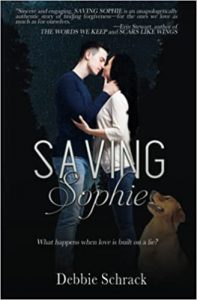You’ve Got to Have Grit: My Path to Publication
by Debbie Schrack
 One of my favorite novels of all time is a classic western by Charles Portis called True Grit. In the story, fourteen-year-old Mattie Ross teams up with a burned-out U.S. marshal and a Texas ranger to pursue her father’s killer, Tom Chaney, through hostile territory. Although Mattie doesn’t have the experience of the two men, she has the grit that propels them to find Tom Chaney and bring him to justice.
One of my favorite novels of all time is a classic western by Charles Portis called True Grit. In the story, fourteen-year-old Mattie Ross teams up with a burned-out U.S. marshal and a Texas ranger to pursue her father’s killer, Tom Chaney, through hostile territory. Although Mattie doesn’t have the experience of the two men, she has the grit that propels them to find Tom Chaney and bring him to justice.
The word “grit” has become a buzzword in recent years. It means courage, resolve, strength of character. It also means not giving up, even when a goal appears unreachable. We see grit in the faces of Olympic athletes, hear it in the breaths of racehorses crossing a finish line, read it between the lines of novels into which authors have poured their hearts and souls.
It’s difficult to say whether grit is part of our genetic programming or something that we learn as we grow. I’ll admit I didn’t have it in my youth. I was a shy, insecure child, and rejection of any kind bordered on catastrophe. I was well into my forties before I became serious about becoming an author. Writing a novel and having it published had always been on my bucket list, although it seemed like an unimaginable possibility. But one day I woke up and thought: I can do this. How hard can it be? That was the beginning of my writing journey.
Looking back now, if there was a movie title that could sum up my early days of writing it would be Clueless. I had no idea what I was doing. I just wrote. As a teacher, I felt that writing children’s books would be a natural fit for me. I was drawn to young adult fiction because of my experience working in high school settings, but also because I loved the genre. YA books are some of the most well-written books I have ever read, full of drama and emotion. I wanted to write that. I wrote three books in quick succession that were mostly awful, but my family and friends were encouraging.
For my fourth novel, Saving Sophie, I came up with the idea of a teenage boy who falls in love with the sole survivor of a car accident caused by his brother. I wrote it in an Advanced Novel Writing course through Writer’s Digest. Our assignment was to turn in fifteen thousand words every three weeks for fifteen weeks. The words flowed easily. By the end of the course, I had a finished novel, and for the first time, encouragement from fellow writers. In his final comments, my writing instructor wrote, “This should be published.” Wow.
Happy ending, right? Not quite.
That was just the beginning of a ten-year cycle of submissions, rejections and revisions, underscored by frustration, disappointment and at rare times, euphoria. I had no idea how much grit it would take to break into the publishing world or how the odds were stacked against debut authors, especially in the saturated world of YA fiction. Rejections from all over the country fell like leaves into my inbox. The criticism hurt. After all, Sophie was my child. But that was far better than being ghosted by an agent, which happened with alarming frequency. Getting my book published felt similar to finding a needle in a haystack, or winning the Powerball.
As I forged on, I read books on the craft of writing like Save the Cat Writes a Novel, and spiritual self-help books like The Four Agreements. I watched webinars on writing for young adults and kept submitting. It was gold to find a literary agent just starting out, or a contest for unpublished novels. I attended writing conferences and studiously took notes, secretly wishing I was one of those writers signing books and displaying their covers on the big screens at the front of the auditorium. I joined two different critique groups that were lifelines. I wrote another book. At the time, I knew I was putting in the work it takes to become a better writer. But it was so hard. I’m not sure if it was grit that kept me going or sheer stubbornness. I just kept moving forward.
Five years in, I came across a contest called Pitch Madness, which involved sending in a pitch and the first two hundred and fifty words of my novel. I debated, then dusted off Sophie, rewrote the opening, and submitted it. Surprisingly, I got interest from several agents and within a week, I had an offer of representation. Wow.
Happy ending, right? Again, not quite.
My amazing agent, Tina P. Schwarz of the Purcell Agency, started sending Saving Sophie out on submission. Many of the editors asked for full manuscripts, which was encouraging, but I still ended up with tons of rejections and zero offers. Somehow, I found myself entrenched in the same defeating cycle I had been in before. The critiques that came with the rejections were confusing. The editors liked my book, they thought it had heart, but…There was always a “but.” It turns out the recipe for getting published was not only an extra helping of grit, but also a side order of humble pie.
After another five years and two major rewrites, we decided to send Sophie off to a few smaller publishers. And one day the unthinkable happened. I got an offer for publication. I was so stunned I didn’t even do the happy dance I had been planning for the occasion. Even now, three months away from publication, it hardly seems real.
But…I did it. Somehow, I reached my impossible goal and got my happy ending. It took grit, hard work, a lot of help and pure luck.
And if I can do it, anyone can.
—
DEBBIE SCHRACK, Saving Sophie
 Seventeen-year-old Gabe Hunter knows he has a purpose in life. He has always strived to be the “best of the best,” but lately nothing has gone his way. Gabe was devastated six months earlier when his half-brother Josh had a drunk driving accident that killed four members of a family and left a sixteen-year-old girl named Sophie an orphan. Josh went to prison and Gabe struggles to forgive him because how can he forgive the unforgivable? When Gabe reluctantly agrees to do math tutoring for his senior service project, he discovers that the girl he will be tutoring is also named Sophie. But in a town of eighty thousand people, what are the odds it will be the same person? Astronomical, Gabe figures.
Seventeen-year-old Gabe Hunter knows he has a purpose in life. He has always strived to be the “best of the best,” but lately nothing has gone his way. Gabe was devastated six months earlier when his half-brother Josh had a drunk driving accident that killed four members of a family and left a sixteen-year-old girl named Sophie an orphan. Josh went to prison and Gabe struggles to forgive him because how can he forgive the unforgivable? When Gabe reluctantly agrees to do math tutoring for his senior service project, he discovers that the girl he will be tutoring is also named Sophie. But in a town of eighty thousand people, what are the odds it will be the same person? Astronomical, Gabe figures.
Gabe soon discovers, though, that it is the same Sophie. A former National Merit Scholar finalist, Sophie had a severe brain injury in the accident. She has seizures, amnesia, and can barely read or write. When he meets her, Gabe realizes what his purpose in life must be—to help Sophie and make amends for his brother. His plan is to spend the rest of the school year tutoring Sophie, then say goodbye and go quietly off to college without ever telling her that his brother was the one who killed her family. What Gabe doesn’t count on is falling in love.
BUY HERE
Debbie Schrack has spent her professional life working with children and young adults. She has a B.S in Special Education from the University of Virginia, and an M.Ed. from George Mason University. Although the character Sophie in her debut novel SAVING SOPHIE is fictional, she is a composite of many of the struggling learners Debbie has taught over the years.
Debbie lives with her family in Fairfax, Virginia, a suburb of Washington, D.C. Debbie finds personal fulfillment in creating new things, whether it be a novel, a painting, or a batch of croissants. She loves animals, and horses are her special passion. When she’s not writing or horseback riding, Debbie is a sucker for musicals, enjoys visiting art galleries, and desperately wants to travel more. She also loves hanging out with her three children, who she will always consider her most amazing creations.
Check out Debbie’s website https://www.debbieschrackbooks.com or follow her on Twitter @debbie_schrack or on Facebook.
Category: Contemporary Women Writers, How To and Tips
























I love this! I want to be a published author too, and I know I still have a long, tough road ahead.